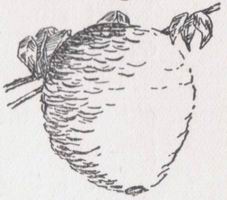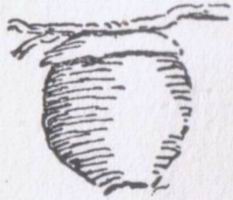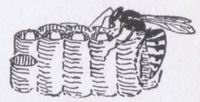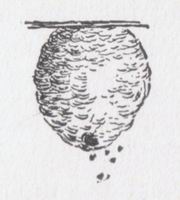|
1999-2004 (Return to Web Text-ures) |
Click Here to return to |
|
1999-2004 (Return to Web Text-ures) |
Click Here to return to |
TAKING NESTS
 WHOEVER aspires to owning a family of tame
hornets should begin operations early in the season, when the little ball-like
nest can be easily and safely taken after nightfall, with the queen at home. The
wasps will not desert the nest so long as the queen is not lost. If not
frightened or hurt they soon make friends with their captor.
WHOEVER aspires to owning a family of tame
hornets should begin operations early in the season, when the little ball-like
nest can be easily and safely taken after nightfall, with the queen at home. The
wasps will not desert the nest so long as the queen is not lost. If not
frightened or hurt they soon make friends with their captor.
As few people, however, will have the opportunity, or inclination, to capture a nest of live wasps and manipulate it so as to see what is going on inside, a better way to satisfy one's craving for a knowledge of wasps, is to wait until about the middle of September, then, having found a yellow-jacket's nest in a convenient location (on the eaves of a building is good), wait until some cool evening when the wasps are sluggish.
With a long-handled hoe or other implement suddenly pull the nest down - and run!
Get around a corner of the building out of sight and wait a few minutes.
The wasps will at once cluster on the old site of the nest, not following it to the ground.
When the excitement is over, in five minutes or so, go quietly back, moving slowly and gently, pick up the combs that are scattered on the ground, taking as many wasps as possible on them. Lay the combs in a cardboard box over which place a cover of wire-netting.
Combs can thus be taken without covering the face and hands and without getting stung, though a few stings rightly regarded only add to the zest of the adventure, as a yellow jacket's sting is not a very serious matter, anyway.
Through the netting all the operations of the workers can be watched.
 The combs should be laid in upside down, which
may be a little disconcerting to the occupants but which keeps the mouths of the
cells from resting on the floor of the box and also enables the observer to
watch the process of feeding the larvae.
The combs should be laid in upside down, which
may be a little disconcerting to the occupants but which keeps the mouths of the
cells from resting on the floor of the box and also enables the observer to
watch the process of feeding the larvae.
A little hanging door should have been cut in one end of the box so that food can be put in.
By the middle of September the combs will contain capped cells of workers, drones, and queens, as well as open cells that contain larvae in all stages, and unhatched eggs.
There should be at least a few workers in with the combs to care for the larvae until more workers hatch out.
Soon there will be a large and ever-increasing family. Workers will uncap their cells and come out, then drones will begin to appear, and finally the large and handsome queens will come forth, and all will industriously feed the remaining larvae.
Honey or syrup should be supplied as food to the adult wasps, and flies or raw meat should be given them to feed the larvae.
They feed the larvae some syrup or honey, but like to add animal food to the diet.
A wasp will bite out a bit of raw meat and put it into the mouth of a larva, leaving the infant to chew it up as well as it can.
It is an amusing spectacle to see a combful of larvae each with a bit of red meat in its mouth, upon which it is industriously feeding.
The combs can be successfully watched for several days, the length of time depending upon' the environment, for the young brood exposed to changes of temperature eventually perish before all have completed their transformations. The box should be covered at night and at all times kept away from cold draughts.
A large number of queens, drones, and workers under ordinary circumstances will hatch out under the eye of the observer, and some of the larvae will be sure to spin their cocoons.
When one understands wasps and their habits, the common fear of these creatures very largely departs.
It is not difficult to get possession of the combs in a yellow-jacket's nest, and even the stings of these creatures are not so fearful as fancy paints them.
With care one need not get stung. It is astonishing how many liberties one can take with yellow-jackets, if one has knowledge of their ways and exercises self control and intelligence when dealing with them.
Not long since a yellow-jacket's nest was raked down from the eaves of a house, and the operator succeeded in getting several of the combs, with a number of wasps on them.
The combs with pieces of the paper walls were put in a cardboard box and covered with mosquito netting, but this had to be replaced at once by wire netting, as the little captives gnawed their way out the second day of their captivity. Fortunately they were discovered just in time, the box was covered with wire gauze, and the refugees were caught and returned to it.
There were three sizes of cells taken. One comb was composed entirely of small worker-cells, one of drone-cells and one of queen-cells. Several broken combs contained worker-cells only, and in this particular nest each comb contained but one kind of cell. The queen-cells were all capped, and so were most of the drone-cells, but in the worker-comb were larvae of all ages, as well as newly laid eggs.
The workers put in the box with the combs took care of the larvae, and as the combs lay with the mouths of the cells up, the little creatures must have been greatly puzzled by this upside down state of affairs.
 The larvae were no longer hanging head down but
their mouths were still open begging for food, and a lively time the few workers
captured with the combs had, caring for this numerous and ravenous family. Soon,
however, strong little jaws began to gnaw the caps from the cells, then little
heads began to appear and new wasps came forth. These new wasps washed their
hands and cleaned their antennae, and at once began to feed the still uncapped
larvae, that is, after they had satisfied their own hunger.
The larvae were no longer hanging head down but
their mouths were still open begging for food, and a lively time the few workers
captured with the combs had, caring for this numerous and ravenous family. Soon,
however, strong little jaws began to gnaw the caps from the cells, then little
heads began to appear and new wasps came forth. These new wasps washed their
hands and cleaned their antennae, and at once began to feed the still uncapped
larvae, that is, after they had satisfied their own hunger.
The wasps did not try to build up the nest again, but devoted themselves to the larvae and to efforts to escape. It was very interesting to watch them feed the infants, and feed the drones when those large and lazy fellows began to come out of their cells.
One morning a hole was noticed in a queen cell, and a pair of jaws were at work inside enlarging it. The observer was too impatient to await the slow process of my lady's natural emergence, and with a long hat-pin gently assisted her in tearing off the cap. Then forth stepped the handsome young queen, the first of the season.
The workers near her cell greeted her appearance with some show of interest, running to her, caressing her with their antennae, and feeding her from their mouths, though they had paid no attention to the coming forth of drones or workers.
The queen differs from the workers in her fuller development. She doubtless is the product of abundant nutriment.
We know the queen bee is produced by special feeding and no doubt it is the same with the wasps. The queen wasps differ in size, though not as much as the drones.
After the first queen had come forth others followed in quick succession and the box was soon buzzing with a large number of queens, drones, and workers.
Taking a wasp's nest in the fall of the year is not as unkind as it may appear, since the workers and drones must soon perish anyway, and even the last of the eggs and larvae in the course of nature fail to mature, and perish from cold in their cells. When the wasps have been watched for a few days and one's curiosity is satisfied, the kindly naturalist will allow the captives their freedom, thus preserving the queens to start new nests the next year. The queens cannot mate in captivity, this function being performed on the wing, and they will not live the natural span of their lives unless freed soon after coming from their cradle cells.
Under ordinary circumstances wasps should not be destroyed, as they are our good friends, keeping down the hordes of insects injurious to vegetation.
